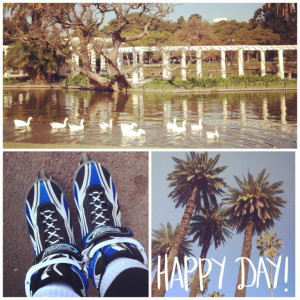Palermo is the barrio (neighborhood) in Buenos Aires that I call home. Characterized by great parks, museums, restaurants, bars, and cafés, there’s no better place to be. If it’s a nice day in Buenos Aires, head over to the Palermo Woods, City Zoo, or the Botanical Garden. If you’re in the mood for world-class museums, visit the Buenos Aires Latin American Art Museum or Evita Museum.
With so many awesome things to do, you’ll find yourself returning again and again this barrio. Here are some of my favorite things to do in Palermo. (I’ve included a custom map of things to do and places to eat at the end of this article.)
What to Do in Palermo
Bosques de Palermo (Palermo Woods)
Bosques de Palermo (Palermo Woods), officially named Parque Tres de Febrero, is one of my favorite parks to visit, especially on a warm, sunny, Buenos Aires day. It’s an enormous, beautiful park (almost 1,000 acres), and includes three lakes, the Paseo del Rosedal (Rose Garden), the Galileo Galilei planetarium, and the Japanese Garden. You could spend an entire day seeing everything in Palermo Woods.
There are also many smooth paths that are great for running, biking, or roller blading along (which you can rent at the park). Pack a picnic lunch or buy choripan from one of the many vendors in the park, and enjoy lunch under a shady tree with the geese.
Tip: While the park is safe during the daytime, I would not recommend visiting the park at night. I’ve read reviews that there are illicit adult activities that may take place there at night.
Bosques de Palermo
Av Del Libertador & Dorrego y Figueroa Alcorta
Jardín Zoológico (Zoo Garden)
Not far from Palermo Woods is Buenos Aires’ City Zoo, Jardín Zoológico (Zoo Garden), which is not to be missed if you have children or if you enjoy visiting zoos. The highlight of this visit, for adults and kids alike, is getting to feed the animals, especially those wandering freely around the zoo grounds. There are maras, ducks, geese, and coypus running around the zoo. You can purchase a bucket or bag of food at the front gate and have fun feeding the approved animals indicated on the list.
In addition to feeding the animals, I especially enjoyed seeing the white tiger cubs, spectacled bears, anteater, alpacas, llamas, and all the monkeys. There is also a reptile house, a small aquarium, and a petting zoo of farm animals.
If you go expecting a state-of-the-art, modern zoo, you will be disappointed. The structures and enclosures were built in the late 1800s and early 1900s, and though a little dilapidated, add to the charm of this old city zoo. I especially loved the carousel, the aviaries, and the monkey enclosure. All the information about the animals is in Spanish, so this is a good time to brush up on animal names in Spanish.
Jardín Zoológico
Av. Las Heras 4440 (Av. Sarmiento y Las Heras)
www.zoobuenosaires.com.ar/
Tel: (5411) 4011-9999
Admission: AR$120 (Free admission for kids 12 and under.)
Open daily from 10 a.m. to 6:00 p.m.
Jardín Botánico “Carlos Thays” (Botanical Garden)
Across the street from the Jardín Zoológico in the heart of Palermo is the Jardín Botánico “Carlos Thays” (Botanical Garden). Carlos Thays was Buenos Aires’ Director of Parks & Walkways in the late 1800s; his work can be seen throughout the city in its many parks and plazas. In Palermo alone, Thays designed Palermo Woods, the Zoo Gardens, Plaza Italia, and the Botanical Garden.
The mansion that sits in the center of the Botanical Garden was constructed in 1881; it was here that Thays lived while working on the Botanical Garden. He planted sections of plants from all over the world. It is possible that as you wander through the park, you may find plants from your home country. There are also many plants native to Argentina. The garden also serves as the city’s cat sanctuary, caring for and finding new homes for the homeless cats of Buenos Aires.
There are five green houses in the garden, the largest of which is a spectacular sight. Constructed in 1889 in Paris, then brought to Argentina in pieces, this beautiful green house contains over 2,000 tropical plants. Because of the green houses and the diversity of the plants, this garden is lush and green year-round.
As you stroll through the garden, you will also notice many different sculptures. Two of my favorite sculptures are the Indicador Meteorológico (Weather Indicator) by José Marcovich and Saturnalia by Ernesto Biondi. There are over 30 sculptures spread throughout the garden, making it an enjoyable place to wander around.
Jardín Botánico “Carlos Thays”
Av. Santa Fe 3951
www.buenosaires.gob.ar/jardinbotanico
Tel: (5411) 4832-1552
Free admission
Open Tuesdays to Fridays from 8:00 a.m. to 6:45 p.m. (5:45 p.m. in winter)
Open Saturdays, Sundays and holidays from 9:30 a.m. to 6:45 p.m. (5:45 p.m. in winter)
Closed Mondays.
MALBA
Any trip to a new city should include a visit to a relevant art museum. A great option when visiting Buenos Aires is the MALBA, Museo de Arte Latinoamericano de Buenos Aires (Buenos Aires Latin American Art Museum). The permanent collection showcases paintings, photographs, sculptures, and installations by artists from the Caribbean, and Central and South America.
Here are some pictures of my favorite works in the MALBA: “The Widower” by Fernando Botero (Colombia), “Portrait of Ramon Gomez de la Serna” by Diego Rivera (Mexico), “Self-portrait with Monkey and Parrot” by Frida Kahlo (Mexico), and “Protest” by Antonio Berni (Argentina). “Protest” and “The Widower” are both huge paintings; I’d seen pictures of these paintings before, but I didn’t realize how large they were until I was standing in front of them.
The MALBA has some incredible works of art definitely worth seeing in person. The permanent collection takes an hour or less to visit, and the temporary exhibit takes another hour, making this museum fit easily into any Buenos Aires itinerary. There is also a nice restaurant at the museum should you need lunch or dinner after visiting the MALBA.
MALBA
Av Figueroa Alcorta 3415
Tel: (5411) 4808-6500
www.malba.org.ar/
Admission: AR$50 (AR$25 on Wednesdays)
Open Thursdays to Mondays 12:00 to 8:00 p.m.
Open Wednesdays 12:00 to 9:00 p.m.
Closed Tuesdays
Museo Evita (Evita Museum)
If I had been asked to name a famous Argentine prior to living in Argentina, I would certainly have named Eva Perón. I remember first watching the movie-musical Evita with my mom years ago. Her story has intrigued me ever since. Much like the movie suggests, there were (and are) Argentines who did not agree with her rise to power or her politics and others who viewed her as a saint. I was excited to visit Museo Evita (Evita Museum) to learn more about her life.
The building that the museum is housed in is gorgeous and is also a part of Eva’s history; it once served as one of the transition houses for women and children that Eva put into place during Perón’s time in office. The rooms of the museum take you through Eva’s life, starting with her early years with her family and her time as a radio and movie actress. The upstairs rooms chronicle her life with Perón, including her many programs intended to improve the lives of women, children, and economically disadvantaged in Argentina. Eva’s dresses, hats, and handbags are also on display next to photographs of her wearing them. Finally, her declining health and death are documented; there is an interesting video that shows her funeral and the thousands of people paying their respects to her.
Visiting Museo Evita is a great way to learn more about the life of Eva Perón and about Argentina during this time period. Most of the signs are translated into English, but there is also an English audio guide available to rent. There is also a nice restaurant in the museum that serves homemade pastas and other tasty Argentine dishes.
Museo Evita
Lafinur 2988
www.museoevita.org/
Tel: (5411) 4807-0306
Admission: AR$40
AR$60 for English audio guide
Open from Tuesdays to Sundays from 11:00 a.m. to 7:00 pm.
Closed Mondays
Museo Nacional de Arte Decorativo (National Museum of Decorative Arts)
I must confess that I almost didn’t visit the Museo Nacional de Arte Decorativo (National Museum of Decorative Arts) because its name made it sound extremely boring. However, I’m very glad that I did not let the name detour me, as this turned out to be one of my favorite museums in Buenos Aires.
The museum is housed in the former palace of the Errázuriz Alvear family. This palace, completed in 1917, was designed by a French architect and constructed with many materials from Europe. It is the only palace of its kind in Buenos Aires that is open to the public. Walking through the palace itself is part of the incredible experience. The main hall is particularly impressive, with its high ceilings, enormous fire place, and five, giant chandeliers.
As you explore the different parts of the palace, there are signs in English and Spanish where you can read about the life of the family, how they used each room, and information about the art.
Spread throughout this incredible museum are thousands of works of art, including sculptures, paintings, tapestries, porcelain, furniture, and the most important collection of miniature portraits in Latin America. I thought the diverse display of art was intriguing: sculptures by Rodin next to sculptures from the Ming Dynasty, the Blessed Virgin Mary next to Medusa. It seemed that every corner I turned, something interesting caught my attention.
Visiting the National Museum of Decorative Arts is a great way to immerse yourself in art, while getting a glimpse of how the wealthy lived during the early 20th century in Buenos Aires. I promise, you’ll leave wishing you could stay longer (“Can’t I live here?”). In addition to the permanent collection, there are also temporary exhibits. For updated information about the temporary exhibits, as well as information about guided tours in English, check out the museum’s website. Should you find that you are hungry, there is a very nice restaurant on the estate.
National Museum of Decorative Arts
Av.del Libertador 1902
mnad.org/
Tel: (5411) 4801-8248
Admission: AR$20 (Free on Tuesdays)
Open Tuesdays to Sundays 2:00 p.m. to 7:00 p.m.
Closed Mondays (Closed Sundays in January and February)
How to Get Around
The subway is a great way to get to Palermo from the city center or from Belgrano, but it doesn’t help when navigating within Palermo. Much is within walking distance; however, Palermo is the largest neighborhood in Buenos Aires, so you may find yourself needing to hop in a taxi here and there. Renting a bicycle or taking a bus can be a good alternative modes of transportation as well.
Did I leave any of your favorite things to do in Palermo off my list? Please tell me! I’m always eager to visit new sights.
Planning a trip? Check out all my articles about Buenos Aires here!


















Pingback: Rebecca's International Kitchen - Exploring Buenos Aires: Where to Eat in Palermo %%
Pingback: Rebecca's International Kitchen - Exploring Buenos Aires: What to Do & Where to Eat in Recoleta %%
Pingback: Rebecca's International Kitchen - What to Do and Where to Eat in Downtown Buenos Aires
Pingback: Rebecca's International Kitchen - Exploring Buenos Aires: Feria de Mataderos
Pingback: Rebecca's International Kitchen - Buenos Aires: What to Do and Where to Eat in San Telmo
Pingback: Rebecca's International Kitchen - Exploring Buenos Aires: Where to Eat in Villa Crespo